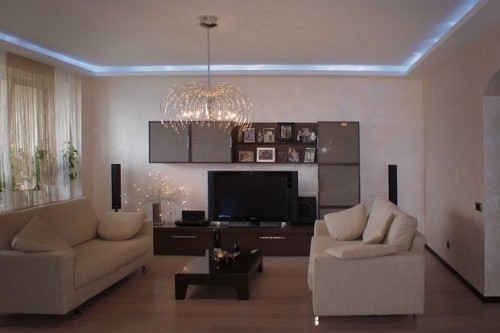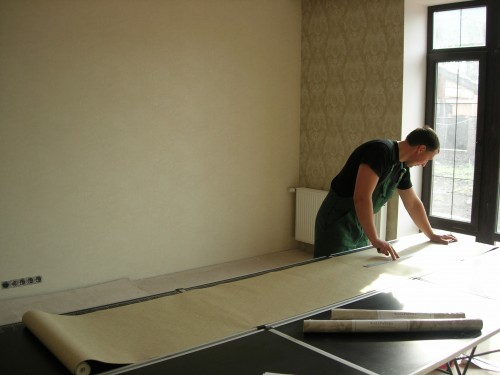Repair is a troublesome and expensive business. But if you really want to change something in your home, the simplest thing you can do on your own is to re-paste the boring wallpaper. If your choice is satin wallpaper, then before starting work on the disposal of old wallpapers, you need to carefully plan everything - purchase the necessary tools, measure the right number of rolls, calculate how much glue will be needed, and also choose a pleasant color of the canvas for you. These are the most pleasant chores, because it is thanks to the huge choice of varieties of drawings and colors, satin wallpapers and are popular and have positive reviews.
Content
What are satin wallpaper?
Wallpaper is a special roll material, which is created for decoration in the room of walls and ceilings. And the walls are applied with special glue. Wallpaper have a different base - either this is paper, or it is vinyl, or it is an outbuilding. In addition, the wallpaper has a different external coating.
The following categories of wallpaper are most often distinguished:
- Paper.
- Vinyl.
- Non -woven.
- Textile.
- Velor.
- For painting.
- Glass wallpaper.
- Wallpaper.
Satin wallpapers belong to the category of “vinyl” wallpaper, as they are also called “flat vinyl”. Another very common name for satin wallpapers is silkography.
Satin wallpaper is made using hot embossing of various drawings to the surface of the wallpaper. Thanks to this technique, even the most daring and unusual design solutions can be realized into reality. Despite the drawings, the surface of these wallpaper is always smooth and silky to the touch. Satin wallpaper can be both matte and mother -of -pearl or with spraying.
One of the misconceptions of consumers (by the way, it is often fed by negligent sellers) - satin wallpaper is made from silk threads - hence the name “Silkography”. In fact, this is not at all the case. Of course, thanks to the latest technologies, most often satin wallpapers imitate silk fabric, but all this is only thanks to a very complex and, of course, an expensive method of processing vinyl. The highest quality satin wallpaper is made in Germany.
How to glue satin wallpaper
Silkography refers to heavy types of wallpaper. In general, gluing satin wallpapers is similar to fastening the usual non -woven coating, but there are its characteristics and rules. For example, due to the lack of any relief on satin wallpaper, it is necessary to carefully prepare the surface on which the canvases will be applied. For example, on the walls it is advisable to make at least a careless woman.
The most basic difference between satin wallpaper and others is to apply the glue not to wallpaper, but to the wall, since it is correct to glue dry canvases on a moistened surface.
What will be needed for work
- Wallpaper.
- Glue.
- Soap solution.
- Scissors.
- Knife.
- Plumb.
- Primer.
- Pencil.
- Ruler.
- Spatula.
- Level.
- Rule (from metal).
- Fighting.
- Roller (from rubber).
- Brush.
- Dry rags.
- Structural paper.
- Water.
- La glue dishes.
- Staircase Strike.
Preparation of walls
How to glue silk -screen printing on old wallpaper
First of all, it is necessary to remove the old wallpaper from the walls.
- Thoroughly moisten the walls with a soap solution and leave them for 45-50 minutes.
- If the wallpaper is very thick, it is better to add dry glue to the soap solution.
- To moisten the wallpaper well, make cuts on them.
- Remove the old wallpaper with a spatula.
How to glue wallpaper wallpaper
If you need paint to the walls on which you plan to stick satin wallpaper, then you need to get rid of it only in one case - if the painted surface is old and peeling off. If the paint holds well, there are no chips and cracks on the wall, then wash the surface thoroughly and glue the canvas on it.
In the event that the paint is old, then it needs to be rid of it - with the help of reagents, and then clean the surface with a brush to work on metal.
How to glue wallpaper on drywall
Despite the fact that drywall is a perfectly flat surface to glue wallpaper, it is undesirable to glue satin on them. Previously, you need to process the necessary surface with a primer, and then putty - starting and finish, and then again with a primer.
How to glue wallpaper on plaster
Do not glue silk -screen into bare plaster. Previously, it is necessary to remove the upper layer of lime, and all the chips and the crack are scattered. The surface prepared in this way must be washed with warm water, and then polished.
How to glue wallpaper on concrete
It is strictly contraindicated to glue satin wallpaper (like many others, however) on concrete, since spots may appear on the wallpaper. Before gluing wallpaper, concrete must be plastered, and then treated with soil.
How to align the walls
If satin canvases fall ugly, then all your efforts will go around the drain, so the work depends on how you prepare the walls.
- Carefully check the surface on which you will glue silkography.
- Remove the plaster that holds poorly - it is better to put it over again than cross the wallpaper.
- The walls that you have leveled by putty will need to be well cleaned - using sandpaper.
- Before gluing wallpaper, wipe the walls from dust and dirt again - use a primer for these purposes.
- The old coatings that were on the walls often hide mold and bending, so it is necessary to carefully prepare the walls.
- The satin wallpaper has a paper base - it can bloom and fall off if the walls are not prepared properly.
How to prepare glue
- For gluing satin wallpapers, buy a special glue for vinyl wallpaper - it is based on PVA. But the usual glue for the “universal” wallpaper is also suitable.
- Read the instructions carefully and dilute the glue as it is written - in accordance with the proportions.
- Do not wait until the glue swells - apply it to the wall, where it dries a little. Thanks to this, the clutch of wallpaper with the wall will be very high.
How to prepare wallpaper
As soon as the walls are ready for gluing wallpaper, you need to prepare the wallpaper themselves.
- Basically, from one rolls of wallpaper, for which there is no need to select a drawing, three or four stripes come out.
- If you need to select a drawing, then more than three stripes will not come out of one roll of wallpaper.
- Measure the walls, measure the required length of the wallpaper and add a little-five to eight centimeters to the reserve.
- Fold the cut strips with a pile, the front side down.
Stages of work
- The first strip of wallpaper must be glued near the window, and then continue to move around the perimeter.
- It is best to join from the upper edge.
- The wallpaper strip is applied as tightly as possible under the ceiling, and then straightened from above - down.
- If you do not want a skew, glue the first strip with a slope or in level, so that everything is strictly perpendicular to the ceiling and floor.
- All other stripes should be placed strictly in the same way.
- If the wallpaper with the pattern, first select the drawing and put the wallpaper in the sequence in which they should go.
- Getting wet, satin wallpaper can stretch, and drying out - contract. Do not stretch the wallpaper at the joints, because the gaps can remain - the gaps between the stripes.
- Ideally, satin wallpaper must be glued over - at least one millimeter.
- Under the wallpaper at the junctions you can glue a paper strip.
- Wallpaper is smoothed on the walls with a roller - thanks to this, you can drive out air. A roller must move from the center of the strip to the edges.
- If you did not notice that there was air under the wallpaper, you need to pierce the bubble with a needle or pin, and then press a little on the bubble so that the air comes out.
- Make sure that two stripes are connected at the corners - it is advisable to make the joint with the application - its depth depends only on how even corners.
- When you have glued the whole room, you can start cutting off excess wallpaper - first with a sharp knife you need to cut off everything unnecessary under the ceiling, and then near the floor.
- Leave the room for a few days so that the wallpaper is well dried.
- As soon as the wallpaper dries and the walls dry out, you can beat the baseboard and glue the curb on the ceiling.
How to glue satin wallpaper on the ceiling
Poking on the wallpaper on the ceiling is a very laborious work: firstly, it is physically inconvenient to do, secondly, it is not easy to leve the canvas, and thirdly, there is no irregularity and error.
- Before glue satin wallpaper on the ceiling, it is necessary to stick special structural paper.
- Wallpaper on the ceiling is glued from the window deep into the room. Thanks to this, you can visually hide the joints.
- Do not glue wallpaper on the ceiling yourself - invite the assistant for these purposes - together the work will advance both faster and better.
- After the wallpaper is glued, you will need to ensure tightness in the room, otherwise defects may appear from drafts.

















